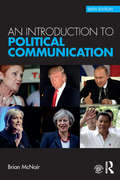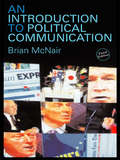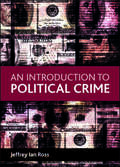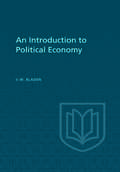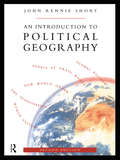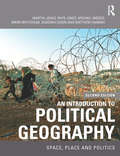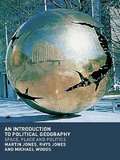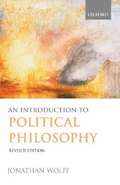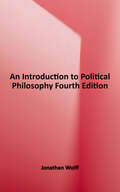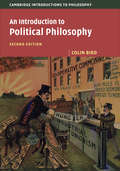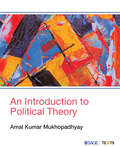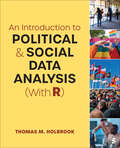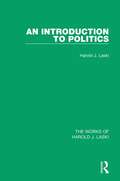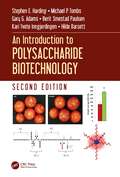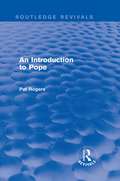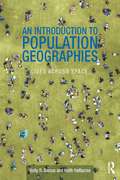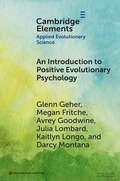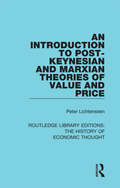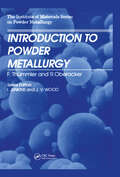- Table View
- List View
An Introduction to Political Communication (Communication and Society #5)
by Brian McNairAt a time of radical shifts in power across the globe, the sixth edition of An Introduction to Political Communication examines the role of the media in the political process. Brian McNair reflects on the role of communication in key events such as the referendum vote for the UK’s withdrawal from the European Union, the rise of nationalist populism in Europe, and the victory of Donald Trump in the 2016 US presidential election. He explores the use of communication as a weapon by Islamic State and other insurgent organisations, and by Putin’s Russia in its dealings with the West, including the hacking of Democratic Party emails in 2016. McNair argues that an expanding globalised public sphere and digital media network have transformed political communication, allowing political actors, from politicians and pressure groups to trade unions and terrorist organisations, to bypass traditional, established media in communicating their messages. This sixth edition of McNair’s classic text has been comprehensively revised and updated to include: the 2016 US presidential election and Donald Trump’s rise to power; the UK’s EU referendum of 2016, the Scottish independence referendum of 2014 and the ‘snap’ UK general election of June 2017; the growing role in political communication of the internet and social media platforms such as Twitter, Facebook and YouTube, and their destabilising impact on the management of political crises all over the world including the shooting down of Malaysian Airlines MH17 and the disappearance of MH370, the Tianjin disaster in China and the Russian intervention in Ukraine; Islamic State’s global jihad, and the use of social media as an instrument of terror; the growing capacity of WikiLeaks and other online sources, such as the International Consortium of Investigative Journalists, to challenge elite control of information.
An Introduction to Political Communication (Communication and Society Ser. #5)
by Brian McnairAn Introduction to Political Communication explores the relationship between politics, the media and democracy in the UK, the USA and other contemporary societies. Brian McNair examines how politicians, trade unions, pressure groups, non-governmental organizations and terrorist organizations make use of the media. Separate chapters look at political media and their effects, the work of political advertising, marketing and public relations and the communication practices of organizations at all levels, from grassroots campaigning through to governments and international bodies.Recent developments covered in the new edition include:* the re-election of New Labour in 2001* the changes in government information and communication policy introduced by the Blair administration since 1997* the 2000 election of George W. Bush in the United States* the NATO interventions in Kosovo and the former Yugoslavia* the implications for international political communication of September 11* the emergence of Al-Quaida and the war on terror.
An Introduction to Political Crime
by Jeffrey Ian RossIn An introduction to political crime, Jeffrey Ian Ross provides the most comprehensive and contemporary analysis of political crime addressing both violent and nonviolent crimes committed by and against the state (e.g. political corruption, illegal domestic surveillance, and human rights violations) in the United States, Canada, United Kingdom and other advanced industrialized democracies since the 1960s. Written by a respected social scientist, this book reviews appropriate theories of political crime and explains numerous definitional and conceptual issues, causes of political crimes, ways to control it, and effects of different types of political crime. Ross integrates new scholarship on state crime, and post 9/11 developments in both scholarship and current affairs and uses numerous examples to help readers understand the issues. The book is supported by a companion website, containing additional materials for both students and lecturers, which is available from the link above.
An Introduction to Political Economy
by Vincent BladenNewly revised by the author (1956), this text-book for beginning students is also designed for general readers who want to know what economics is and how economists think. It analyses the size and composition of the wage-earner in modern industry, Canadian public policy in relation to combines, and the the social problems of the special problems of the Canadian wheat-growing and newsprint industries. "...an interesting, instructive, and valuable book full of essential information."
An Introduction to Political Geography
by John Rennie ShortOld powers are falling. New states are emerging. The gap between East and West is narrowing. What are the problems facing the emerging new world order? Can action at the community level affect global issues?An Introduction to Political Geography, in its first edition helped shape the study of the discipline. Entirely revised and updated, this new edition explores political and geographic change within the same accessible framework. John Short emphasises the need for a fluid approach to the study of the international order, the nation state, as well as social movements.Though the world is becoming smaller, popular access to power remains an elusive goal. An integrated world economy may well perpetuate past inequalities just as political systems continue to work by exclusion. The global village and the ecological approach this implies, must be paid particular attention when examining the political geography of participation. An Introduction to Political Geography reviews the history of the rise and fall of centres of power, draws on a wide range of detailed international case studies to illustrate current trends, and discusses future developments.
An Introduction to Political Geography: Space, Place and Politics
by Rhys Jones Mark Whitehead Martin Jones Michael Woods Matthew Hannah Deborah DixonAn Introduction to Political Geography continues to provide a broad-based introduction to contemporary political geography for students following undergraduate degree courses in geography and related subjects. The text explores the full breadth of contemporary political geography, covering not only traditional concerns such as the state, geopolitics, electoral geography and nationalism; but also increasing important areas at the cutting-edge of political geography research including globalization, the geographies of regulation and governance, geographies of policy formulation and delivery, and themes at the intersection of political and cultural geography, including the politics of place consumption, landscapes of power, citizenship, identity politics and geographies of mobilization and resistance. This second edition builds on the strengths of the first. The main changes and enhancements are: four new chapters on: political geographies of globalization, geographies of empire, political geography and the environment and geopolitics and critical geopolitics significant updating and revision of the existing chapters to discuss key developments, drawing on recent academic contributions and political events new case studies, drawing on an increasing number of international and global examples additional boxes for key concepts and an enlarged glossary. As with the first edition, extensive use is made of case study examples, illustrations, explanatory boxes, guides to further reading and a glossary of key terms to present the material in an easily accessible manner. Through employment of these techniques this book introduces students to contributions from a range of social and political theories in the context of empirical case study examples. By providing a basic introduction to such concepts and pointing to pathways into more specialist material, this book serves both as a core text for first- and second- year courses in political geography, and as a resource alongside supplementary textbooks for more specialist third year courses.
An Introduction to Political Geography: Space, Place and Politics
by Rhys Jones Martin Jones Michael WoodsAn Introduction to Political Geography provides a broad-based introduction to how power interacts with space; how place influences political identities; and how policy creates and remoulds territory. By pushing back the boundaries of what we conventionally understand as political geography, the book emphasizes the interactions between power, politics and policy, space, place and territory in different geographical contexts.This is both an essential text for political geographers and also a valuable resource for students of related fields with an interest in politics and geography.
An Introduction to Political Philosophy
by Jonathan WolffThe revised edition of this highly successful text provides a clear and accessible introduction to some of the most important questions of political philosophy. Organized around major issues, Wolff provides the structure that beginners need, while also introducing some distinctive ideas of his own.
An Introduction to Political Philosophy
by Jonathan WolffAn Introduction to Political Philosophy is a concise, lucid, and thought-provoking introduction to the most important questions of political philosophy, organized around the major issues. Wolff provides the structure that beginners need, whilst also introducing some distinctive ideas of his own.
An Introduction to Political Philosophy (Cambridge Introductions to Philosophy)
by Colin BirdNow revised and updated and containing several entirely new chapters, this book provides a comprehensive introduction to political philosophy. It discusses historical and contemporary figures and covers a vast range of topics and debates, including immigration, war, national and global economics, the ethical and political implications of climate change, and the persistence of racial oppression and injustice. It also presents accessible, non-technical discussions of perfectionism, utilitarianism, theories of the social contract, and the Marxian tradition of social criticism. Real-life examples introduce students to ways of using philosophical reflection and debates, and open up new perspectives on politics and political issues. Throughout, this book challenges readers to think critically about political arguments and institutions that they might otherwise take for granted. It will be a vital and provocative resource for any student of philosophy or political science.
An Introduction to Political Philosophy (Routledge Revivals)
by A. R. MurrayFirst published in 1953, this seminal introduction to political philosophy is intended for both the student of political theory and for the general reader. After an introduction which explains the nature and purpose of philosophy, Dr Murray provides a critical examination of the principle theories advanced by political philosophers from Plato to Marx, paying special attention to contemporary issues. The book also makes an attempt to define the essential issues of philosophical significance in contemporary politics, with special reference to the conflict between political authority and individual rights, and to show how the different moral assumptions underlying authoritarian and democratic systems of government are ultimately based upon different theories of logic.
An Introduction to Political Theory
by Amal Kumar MukhopadhyayA precise, analytical and critical account of the fundamentals of political theory and the major concepts used in political analysis. This book offers an introduction to major political theories for the first learners of political science at the graduate level as well as those interested in building a strong groundwork of the subject. It cites Indian and global examples and discusses real-life applications of these theories to make the theories and concepts relatable and approachable. The book offers a compact overview of the concepts of state, society, civil society, justice, law, freedom, equality and others along with critical discussions on premier political ideologies of Marxism, Liberalism, Anarchism, Fascism, Gandhism and much more. Enriched by the author's long-term experience in research and teaching on the subject, this textbook will prove to be an essential companion for students of political science, sociology and social work as well as Civil Services aspirants. Key Features: • Special focus on Indian political theory and the course of its development. • Encourages the readers to ponder and debate further. • Presents a practical perspective, by contextualizing the theories within real-life situations.
An Introduction to Political and Social Data Analysis (With R)
by Thomas M. HolbrookAn Introduction to Political and Social Data Analysis (With R) provides students with an accessible overview of practical data analysis while also providing a gentle introduction to R. By starting with statistics first and using just enough R code to generate results, this text helps students focus on learning how to do data analysis while slowly gaining confidence in using R as they progress through the material. This book is structured around learning by doing. Students can follow along in each chapter by reading about statistics and their applications in R, and then running the R code on their own as they work through contemporary political science and social science examples. Author Thomas M. Holbrook patiently explains each step in in the process, avoiding overly complicated jargon and commands. Exercises at the end of chapters feature both conceptual and calculation-based questions so students can check their understanding of data analysis and practice using R. At the end of the semester, students can confidently add skills in data analysis with R to their resumes.
An Introduction to Political and Social Data Analysis (With R)
by Thomas M. HolbrookAn Introduction to Political and Social Data Analysis (With R) provides students with an accessible overview of practical data analysis while also providing a gentle introduction to R. By starting with statistics first and using just enough R code to generate results, this text helps students focus on learning how to do data analysis while slowly gaining confidence in using R as they progress through the material. This book is structured around learning by doing. Students can follow along in each chapter by reading about statistics and their applications in R, and then running the R code on their own as they work through contemporary political science and social science examples. Author Thomas M. Holbrook patiently explains each step in in the process, avoiding overly complicated jargon and commands. Exercises at the end of chapters feature both conceptual and calculation-based questions so students can check their understanding of data analysis and practice using R. At the end of the semester, students can confidently add skills in data analysis with R to their resumes.
An Introduction to Politics
by T. M. SellThis textbook introduces students to the field of Political Studies. An Introduction to Politics is a little more brief, concise and in-between than similar textbooks currently on the market. Because this is usually a first-year course, overloading a textbook with too much minutiae of the ins and outs of politics can lead to students giving up on the book. Politics is a great story - the story of human existence. A successful textbook needs to tell that story.
An Introduction to Politics (The Works of Harold J. Laski)
by Harold J. LaskiThis volume distils the themes expounded in A Grammar of Politics for the non-specialist reader. It is the best outline of Laski’s views in his transitional period.
An Introduction to Polynomial and Semi-Algebraic Optimization
by Jean Bernard LasserreThis is the first comprehensive introduction to the powerful moment approach for solving global optimization problems (and some related problems) described by polynomials (and even semi-algebraic functions). In particular, the author explains how to use relatively recent results from real algebraic geometry to provide a systematic numerical scheme for computing the optimal value and global minimizers. Indeed, among other things, powerful positivity certificates from real algebraic geometry allow one to define an appropriate hierarchy of semidefinite (SOS) relaxations or LP relaxations whose optimal values converge to the global minimum. Several extensions to related optimization problems are also described. Graduate students, engineers and researchers entering the field can use this book to understand, experiment with and master this new approach through the simple worked examples provided.
An Introduction to Polysaccharide Biotechnology
by Stephen E. Harding Michael P. Tombs Gary G. Adams Berit Smestad Paulsen Kari Tvete Inngjerdingen Hilde BarsettPolysaccharides and related high molecular weight glycans are hugely diverse with wide application in Biotechnology and great opportunities for further exploitation. An Introduction to Polysaccharide Biotechnology – a second edition of the popular original text by Tombs and Harding – introduces students, researchers, clinicians and industrialists to the properties of some of the key materials involved, how these are applied, some of the economic factors concerning their production and how they are characterized for regulatory purposes.
An Introduction to Pope (Routledge Revivals)
by Pat RogersIn this concise introduction to Pope’s life and work, first published in 1975, the poet’s highly successful career as a man of letters is seen against the background of the Augustan age as a whole. Pat Rogers begins by examining the relationship of the eighteenth-century writer to his audience, and discusses the role of style and versification in this. The book covers the whole of Pope’s work and includes not only the translations of Homer and such minor poems as The Temple of Fame, but also the prose, both drama and correspondence. Based on extensive research, this book will provide literature students with a greater appreciation and understanding of Pope’s verse and the ways in which he addressed his eighteenth-century context in his work.
An Introduction to Population Geographies: Lives Across Space
by Holly R. Barcus Keith HalfacreeAn Introduction to Population Geographies provides a foundation to the incredibly diverse, topical and interesting field of twenty-first-century population geography. It establishes the substantive concerns of the subdiscipline, acknowledges the sheer diversity of its approaches, key concepts and theories and engages with the resulting major areas of academic debate that stem from this richness. Written in an accessible style and assuming little prior knowledge of topics covered, yet drawing on a wide range of diverse academic literature, the book’s particular originality comes from its extended definition of population geography that locates it firmly within the multiple geographies of the life course. Consequently, issues such as childhood and adulthood, family dynamics, ageing, everyday mobilities, morbidity and differential ability assume a prominent place alongside the classic population geography triumvirate of births, migrations and deaths. This broader framing of the field allows the book to address more holistically aspects of lives across space often provided little attention in current textbooks. Particular note is given to how these lives are shaped though hybrid social, biological and individual arenas of differential life course experience. By engaging with traditional quantitative perspectives and newer qualitative insights, the authors engage students from the quantitative macro scale of population to the micro individual scale. Aimed at higher-level undergraduate and graduate students, this introductory text provides a well-developed pedagogy, including case studies that illustrate theory, concepts and issues.
An Introduction to Positive Evolutionary Psychology (Elements in Applied Evolutionary Science)
by Glenn Geher Megan Fritche Avrey Goodwine Julia Lombard Kaitlyn Longo Darcy MontanaOver the past few decades, evolutionary psychology has shed light on such features of the human experience as mating, love, religion, aggression, warfare, physical health, mental health, and more. The field of positive psychology has progressed along a parallel trajectory, using behavioral science techniques to help our understanding of human thriving at the individual and community levels. Positive Evolutionary Psychology is dedicated to the integration of positive and evolutionary psychology, with an eye toward using Darwinian-inspired concepts to help advance our understanding of human thriving. This Element describes the basic ideas of this new approach to behavioral science as well as examples that dip into various aspects of the human experience, including such topics as health, education, friendships, love, and more–all with an eye toward providing a roadmap for the application of Darwinian principles to better understanding human thriving and the good life.
An Introduction to Post-Keynesian and Marxian Theories of Value and Price (Routledge Library Editions: The History of Economic Thought)
by Peter M. LichtensteinPeter M. Lichtenstein believes that any social-economic theory of capitalism must begin with a theory of value and price. Dismissing the neoclassical school, he turns to post-Keynesian and Marxian economics with their coherent and consistent theories of value and price based on concrete objective circumstances. The development of these theories in the author’s aim because he believes that this approach comes much closer than neoclassical theory to capturing the essence of a capitalism economy. This book, first published in 1983, is addressed to economics students, especially to those studying microeconomics or the history of economic thought, and to economists seeking an overview of these issues.
An Introduction to Powder Metallurgy
by F. Thummler R. OberackerThis is a comprehensive introduction with some emphasis of the fundamentals of the different processing steps, but, and pays attention also to the main powder metallurgy products including their applications. Since the boundaries between powder metallurgy and advanced ceramics are not definitely fixed and since they are sometimes competitive products, the description of processing includes, to some extent, ceramic materials. A short paragraph on advanced ceramics has been included. This book will be useful for educating students with scientific or technological orientation which have some background in materials science and technology and a special interest in powder metallurgy. This book may also be useful to people in powder metallurgy research and development, as well as for production staff.
An Introduction to Practical Formal Methods Using Temporal Logic
by Michael FisherThe name "temporal logic" may sound complex and daunting; but while they describe potentially complex scenarios, temporal logics are often based on a few simple, and fundamental, concepts - highlighted in this book. An Introduction to Practical Formal Methods Using Temporal Logic provides an introduction to formal methods based on temporal logic, for developing and testing complex computational systems. These methods are supported by many well-developed tools, techniques and results that can be applied to a wide range of systems.Fisher begins with a full introduction to the subject, covering the basics of temporal logic and using a variety of examples, exercises and pointers to more advanced work to help clarify and illustrate the topics discussed. He goes on to describe how this logic can be used to specify a variety of computational systems, looking at issues of linking specifications, concurrency, communication and composition ability. He then analyses temporal specification techniques such as deductive verification, algorithmic verification, and direct execution to develop and verify computational systems. The final chapter on case studies analyses the potential problems that can occur in a range of engineering applications in the areas of robotics, railway signalling, hardware design, ubiquitous computing, intelligent agents, and information security, and explains how temporal logic can improve their accuracy and reliability.Models temporal notions and uses them to analyze computational systemsProvides a broad approach to temporal logic across many formal methods - including specification, verification and implementationIntroduces and explains freely available tools based on temporal logics and shows how these can be appliedPresents exercises and pointers to further study in each chapter, as well as an accompanying website providing links to additional systems based upon temporal logic as well as additional material related to the book.
An Introduction to Practical Laboratory Optics
by J. F. JamesAimed at students taking laboratory courses in experimental optics, this book introduces readers to optical instruments and their uses. The book explains the basic operation of lenses, mirrors, telescopes in the laboratory and under field conditions, how to use optical instruments to their maximum potential and how to keep them in working order. It gives an account of the laws of geometrical optics which govern the design, layout and working of optical instruments. The book describes the interactions of polarised light with matter and the instruments and devices derived from this, and discusses the choice of spectrometers and detectors for various spectral regions, with particular attention to CCD cameras. The emphasis throughout is on description, with mathematical precision confined to the appendices, which explain the ray transfer matrix and outline the Seidel theory of optical aberrations. The appendices also introduce Fourier methods in optics and Fourier transform infra-red spectrometry.
